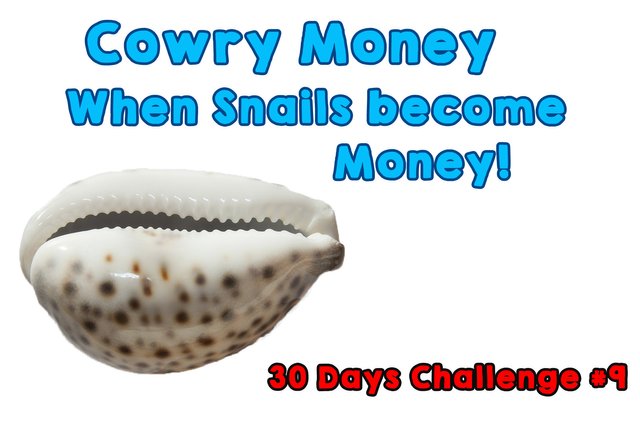Did you ever hear of Shell Money?

While huge stones were used as money on the Yap Islands, in Africa, East and South Asia and the South Seas it was the housing of the cowry snail. I bet one or the other of you had a snail shell like this one, which at first sight seems to give the impression of a shell, already once in your hands. It was the first generally valid money and with its 4,000 years (2,000 B. C. until the late 19th century!) it was in circulation longer than coins and notes will probably ever be.
The snails were naturally only native to certain parts of the world, but mainly to the Maldives. This led to a natural scarcity, similar to the Rai stones in the Yap Islands. The Maldivians developed an effective method of collecting snails: they put coconut leaves in the sea and waited for the snails to settle on them. Afterwards, the leaves and the snails were taken out of the water and dried on the beach so that the snails were killed. The snails were then buried in pits so that the carcasses of the snails were decayed. Good thing there were no vegans at that time who could have protested against it :P.
The snails were often wound on threads and traded as money threads. Every snail was worth the same. Size and weight did not play a significant role.
Value
The market value of Cowry money fluctuated greatly depending on the season and region. Of course, there was no control body that could have controlled the money supply in any way. The money supply was regulated naturally. Since supra-regional trade has functioned very simply for a long time, cowries became generally more expensive the further away one moved away from the coasts.
There was a time when in Uganda, you could buy a woman for two cowries. Due to the large quantities of imported cowry snails, this price gradually increased to 10,000 cowries. After the colonial powers became aware of the enormous profit opportunities offered by cowry snails, they also entered the market and caused a general (hyper)inflation, which ultimately led to the decline of the cowry money.
Sadly, the same story as in the Yap Islands: The Europeans came and destroyed thousands of years old financial systems with their irrepressible greed for money within a few years. Since 1800, about 75 billion cowry screws have been imported into Africa.
Perks
The shells were very robust and could be passed on over generations. They are very light and small, which greatly simplified trading with them. In addition, they were virtually forgery-proof until the invention of porcelain and thus had a huge advantage over coins. In addition, the cowry money was accepted in large parts of Africa and Asia and was thus a precursor of global currencies, which are now completed in the form of cryptocurrencies such as bitcoin.
Handicaps
As a result of rising inflation, the cowry were only handy to pay smaller amounts over time. In India, for example, several million cowry snails had to be paid for the purchase of a house. Imagine how tedious this must have been for the one who had to count those massive amounts of money. A trained counter managed between 200,000 and 300,000 snails a day. I imagine such an everyday working day to be extremely monotonous, would be nothing for me at all :D :D.
That's it for today again. Although I wanted to write about the blockchain for 30 days, I had enough of it. I have noticed that I am lacking in variety when I have to concentrate on a single topic. If you have any questions or additions to this topic, don't hesitate and contact me! :)
See you ;-)
Sources:
http://www.theperfectcurrency.org/main-history-of-money/history-of-money
https://climbcarstensz.wordpress.com/2013/08/02/cowrie-shells-more-than-simply-shell-money/
hey
thank you a lot ! ;)
Great post, thank you, yes I have heard of shell money. 2018 is going to be huge for alternative currencies.
Thank you @arthursen! Let's revive this old currency and give a shit about bitcoin xDD